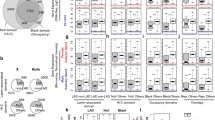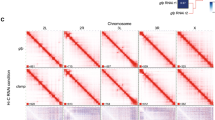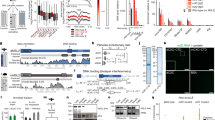Abstract
In Drosophila, dosage compensation requires assembly of the Male Specific Lethal (MSL) protein complex for doubling transcription of most X-linked genes in males. The recognition of the X chromosome by the MSL complex has been suggested to include initial assembly at ~35 chromatin entry sites and subsequent spreading of mature complexes in cis to numerous additional sites along the chromosome. To understand this process further we examined MSL patterns in a range of wild-type and mutant backgrounds producing different amounts of MSL components. Our data support a model in which MSL complex binding to the X is directed by a hierarchy of target sites that display different affinities for the MSL proteins. Chromatin entry sites differ in their ability to provide local intensive binding of complexes to adjacent regions, and need high MSL complex titers to achieve this. We also mapped a set of definite autosomal regions (~70) competent to associate with the functional MSL complex in wild-type males. Overexpression of both MSL1 and MSL2 stabilizes this binding and results in inappropriate MSL binding to the chromocenter and the 4th chromosome. Thus, wild-type MSL complex titers are critical for correct targeting to the X chromosome.







Similar content being viewed by others
References
Akhtar A, Becker PB (2000) Activation of transcription through histone H4 acetylation by MOF, an acetyltransferase essential for dosage compensation in Drosophila. Mol Cell 5:367–375
Akhtar A, Zink D, Becker PB (2000) Chromodomains are protein-RNA interaction modules. Nature 407:405–409
Alekseyenko AA, Demakova OV, Belyaeva ES, Makarevich GF, Kotlikova IV, Nothiger R, Zhimulev IF (2002) Dosage compensation and intercalary heterochromatin in X chromosomes of Drosophila melanogaster. Chromosoma 111:106–113
Baker BS, Gorman M, Marin I (1994) Dosage compensation in Drosophila. Annu Rev Genet 28:491–521
Balasov ML, Makunin IV (1996) Model of continuous and discontinuous chromatin compaction, resulting from position effect variegation. Biol Zentrabl 115:16–23
Bashaw GJ, Baker BS (1996) Dosage compensation and chromatin structure in Drosophila. Curr Opin Genet Dev 6:496–501
Bashaw GJ, Baker BS (1997) The regulation of the Drosophila msl-2 gene reveals a function for Sex-lethal in translational control. Cell 89:789–798
Belote JM, Lucchesi JC (1980) Male-specific lethal mutations in Drosophila melanogaster. Genetics 96:165–186
Belyaeva ES, Zhimulev IF (1991) Cytogenetic and molecular aspects of position effect variegation in Drosophila. III. Continuous and discontinuous compaction of chromosomal material as a result of position effect variegation. Chromosoma 100:453–466
Belyaeva ES, Demakova OV, Umbetova GH, Zhimulev IF (1993) Cytogenetic and molecular aspects of position-effect variegation in Drosophila melanogaster. V. Heterochromatin-associated protein HP1 appears in euchromatic chromosomal regions that are inactivated as a result of position-effect variegation. Chromosoma 102:583–590
Bone JR, Lavender J, Richman R, Palmer MJ, Turner BM, Kuroda MI (1994) Acetylated histone H4 on the male X chromosome is associated with dosage compensation in Drosophila. Genes Dev 8:96–104
Chang KA, Kuroda MI (1998) Modulation of MSL1 abundance in female Drosophila contributes to the sex specificity of dosage compensation. Genetics 150:699–709
Eisen A, Utley RT, Nourani A, Allard S, Schmidt P, Lane WS, Lucchesi JC, Cote J (2001) The yeast NuA4 and Drosophila MSL complexes contain homologous subunits important for transcription regulation. J Biol Chem 276:3484–3491
Franke A, Baker BS (1999) The roX1 and roX2 RNAs are essential components of the compensasome, which mediates dosage compensation in Drosophila. Mol Cell 4:117–122
Gorman M, Kuroda MI, Baker BS (1993) Regulation of the sex-specified binding of the Maleless dosage compensation protein to the male X-chromosomes in Drosophila. Cell 72:39–49
Gu W, Szauter P, Lucchesi JC (1998) Targeting of MOF, a putative histone acetyl transferase, to the X chromosome of Drosophila melanogaster. Dev Genet 22:56–64
Gu W, Wei X, Pannuti A, Lucchesi JC (2000) Targeting the chromatin-remodeling MSL complex of Drosophila to its sites of action on the X chromosome requires both acetyl transferase and ATPase activities. EMBO J 19:5202–5211
Jin Y, Wang Y, Johansen J, Johansen KM (2000) JIL-1, a chromosomal kinase implicated in regulation of chromatin structure, associates with the male specific lethal (MSL) dosage compensation complex. J Cell Biol 149:1005–1010
Kageyama Y, Mengus G, Gilfillan G, Kennedy HG, Stuckenholz C, Kelley RL, Becker PB, Kelley RL, Kuroda MI (2001) Noncoding RNA genes in dosage compensation and imprinting. Cell 29:103(1): 9–12
Kelley RL, Kuroda MI (2000) Noncoding RNA genes in dosage compensation and imprinting. Cell 29:103:9–12
Kelley RL, Solovyeva I, Lyman LM, Richman R, Solovyev V, Kuroda MI (1995) Expression of msl-2 causes assembly of dosage compensation regulators on the X chromosomes and female lethality in Drosophila. Cell 81:867–877
Kelley RL, Wang J, Bell L, Kuroda MI (1997) Sex Lethal controls dosage compensation in Drosophila by a non-splicing mechanism. Nature 387:195–199
Kelley RL, Meller VH, Gordadze PR, Roman G, Davis RL, Kuroda MI (1999) Epigenetic spreading of the Drosophila dosage compensation complex from roX RNA genes into flanking chromatin. Cell 98:513–522
Kuroda MI, Kernan M, Kreber R, Ganetzky B, Baker BS (1991) The Maleless protein associates with the X chromosome to regulate dosage compensation in Drosophila. Cell 66:935–947
Lee CG, Chang KA, Kuroda MI, Hurwitz J (1997) The NTPase/helicase activities of Drosophila Maleless, an essential factor in dosage compensation. EMBO J 16:2671–2681
Lindsley DL, Zimm GG (1992) The genome of Drosophila melanogaster. Academic Press, San Diego, California
Lucchesi JC (1998) Dosage compensation in flies and worms: the ups and downs of X-chromosome regulation. Curr Opin Genet Dev 8:179–184
Lyman LM, Copps K, Rastelli L, Kelley RL, Kuroda MI (1997) Drosophila Male-Specific Lethal-2 protein: structure/function analysis and dependence on MSL-1 for chromosome association. Genetics 147:1743–1753
Meller VH, Rattner BP (2002) The roX genes encode redundant male-specific lethal transcripts required for targeting of the MSL complex. EMBO J 21:1084–1091
Meller VH, Wu KH, Roman G, Kuroda MI, Davis RL (1997) roX1 RNA paints the X chromosome of male Drosophila and is regulated by the dosage compensation system. Cell 88:445–457
Meller VH, Gordadze PR, Park Y, Chu X, Stuckenholz C, Kelley RL, Kuroda MI (2000) Ordered assembly of roX RNAs into MSL complexes on the dosage-compensated X chromosome in Drosophila. Curr Biol 10:136–143
Pannuti A, Lucchesi JC (2000) Recycling to remodel: evolution of dosage-compensation complexes. Curr Opin Genet Dev 10:644–650
Park Y, Kelley RL, Oh H, Kuroda MI, Meller VH (2002) Extent of chromatin spreading determined by roX RNA recruitment of MSL proteins. Science 298:1620–1623
Perrin L, Demakova OV, Fanti L, Kallenbach S, Saingery S, Mal'ceva NI, Pimpinelli S, Zhimulev I, Pradel J (1998) Dynamics of the sub-nuclear distribution of Modulo and the regulation of position-effect variegation by nucleolus in Drosophila. J Cell Sci 111:2753–2761
Ruiz MF, Esteban MR, Donoro C, Goday C, Sanchez L (2000) Evolution of dosage compensation in Diptera: the gene maleless implements dosage compensation in Drosophila (Brachycera suborder) but its homolog in Sciara (Nematocera suborder) appears to play no role in dosage compensation. Genetics 156:1853–1865
Rykowski MC, Parmelee SJ, Agard DA, Sedat JW (1988) Precise determination of the molecular limits of a polytene chromosome band: regulatory sequences for the Notch gene are in the interband. Cell 54:461–472
Sanjuan R, Marin I (2001) Tracing the origin of the compensasome: evolutionary history of DEAH helicase and MYST acetyltransferase gene families. Mol Biol Evol 18:330–343
Schutt C, Nothiger R (2000) Structure, function and evolution of sex-determining systems in Dipteran insects. Development 127:667–677
Smith ER, Pannuti A, Gu W, Steurnagel A, Cook RG, Allis CD, Lucchesi JC (2000) The Drosophila MSL complex acetylates histone H4 at lysine 16, a chromatin modification linked to dosage compensation. Mol Cell Biol 20:312–318
Stuckenholz C, Kageyama Y, Kuroda MI (1999) Guilt by association: non-coding RNAs, chromosome-specific proteins and dosage compensation in Drosophila. Trends Genet 15:454–458
Wang, Y, Zhang W, Jin Y, Johansen J, Johansen KM (2001) The JIL-1 tandem kinase mediates histone H3 phosphorylation and is required for maintenance of chromatin structure in Drosophila. Cell 105:433–443
Weiler KS, Wakimoto BT (1995) Heterochromatin and gene expression in Drosophila. Annu Rev Genet 29:577–605
Zhimulev IF (1998) Polytene chromosomes, heterochromatin and position effect variegation. Adv Genet 37:1–566
Acknowledgements
We thank R.L. Kelley for the gift of transgenic and mutant strains and for critical reading of the manuscript. The help of A.A. Gorchakov in immunoblotting, and critical reading of the manuscript by S.A. Demakov and M.L. Balasov are gratefully acknowledged. This work was supported by FIRCA grant (International Cooperation Program) N1 R03-TW05669-01, grants of Russian Federation (RFBR grants) N 02-04-48222 and 00-15-97984 and the Howard Hughes Medical Institute. M.I.K. is an Investigator of the Howard Hughes Medical Institute. The experiments described here comply with the laws of the country in which the experiments were performed.
Author information
Authors and Affiliations
Corresponding author
Additional information
Communicated by E.R. Schmidt
Rights and permissions
About this article
Cite this article
Demakova, O.V., Kotlikova, I.V., Gordadze, P.R. et al. The MSL complex levels are critical for its correct targeting to the chromosomes in Drosophila melanogaster . Chromosoma 112, 103–115 (2003). https://doi.org/10.1007/s00412-003-0249-1
Received:
Revised:
Accepted:
Published:
Issue Date:
DOI: https://doi.org/10.1007/s00412-003-0249-1




